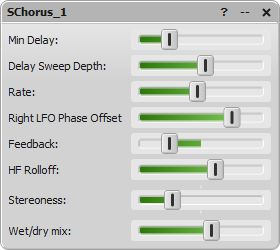| AudioMulch Help > Contraption Reference > Effects | Previous Next |
SChorus
Creates a sweeping, detuned thickening and stereo-widening chorus effect.

SChorus creates a thickening and widening effect which results from mixing the stereo input with delayed, pitch-modulated and stereo-panned versions of the input. Separate, modulated delays are applied to the left and right channels. The lengths of the delays are varied (modulated by LFOs), which detunes the delayed sounds slightly above and below the input.
You can vary the rate of delay change and the amount of delay to alter the amount of detuning. Feedback can be applied to create sweeping resonance effects similar to a flanger or phaser. You can also adjust the mix ratio of the input signal to the effected signal (wet/dry mix).
With SChorus you can process a stereo input and create enhanced stereo effects. One way to do this is by altering the relative phase of the left and right channel delay modulations using the Right LFO Phase Offset parameter. The other way is by using the Stereoness parameter, which controls the width of the stereo panning of the delayed sounds. Settings higher than 100% use phase inversion to create a kind of "super stereo" effect.
With SChorus you can also create a range of more extreme delay modulation effects. For example, by using fast Rate, and/or extreme Feedback settings.
 |
Connecting a patch cord to only one side of a stereo input on this contraption bridges the audio to both inputs. |
 |
See the Adjusting Contraption Properties section for information about using sliders, knobs, presets etc. |
Related Contraptions
Parameters

Min Delay |
Controls the minimum amount that the chorus voices are delayed. This will be most noticeable on percussive sounds, but is also relevant when using the Feedback parameter, as this delay contributes to the tuning of the feedback loops. |
Delay Sweep Depth |
Controls the range of delay used for sweeping. A longer delay swept at the same Rate setting leads to greater detuning (pitch differences) and thus a thicker chorus effect. |
Rate |
Modulation rate. Speed at which the delay sweeps across the full range determined by Delay Sweep Depth. This is the rate at which a triangle wave LFO (low frequency oscillator) sweeps from minimum delay, to maximum, and back to minimum. The rate ranges from 1 cycle every 1000 seconds (0.001 Hz) to 100 cycles per second (100 Hz). |
Right LFO Phase Offset |
Controls the relative phase of the delay modulation in the right channel relative to the left channel, in degrees. Values greater than zero cause the right LFO to lead the left, while values less than zero cause the right LFO to trail the left. Typical values to create a stereo effect are 90 and 180. |
Feedback |
Controls the amount of delayed output fed back into the input of each delay. Creates a pitched resonance similar to a flanger. The Feedback parameter can be set to positive or negative values. At each extreme (-95%/+95%) the sound is more resonant. Each extreme has its own characteristic sound due to the different overtone structures of positive and negative feedback delay loops. |
HF Rolloff (HFRolloffFrequency) |
Reduces the amount of high frequencies fed to the chorus. At its highest setting, the high frequencies will be more or less unaffected, lower values produce a duller tone. This parameter is the cutoff frequency of a 6dB/octave lowpass filter. |
Stereoness |
Controls the width of the stereo panning of the chorused voices. At zero both voices are panned to the center. At 100% the voice derived from the left input channel is panned left, and the voice derived from the right input channel is panned right. Beyond 100% a "super stereo" effect is used that mixes a phase inverted signal in the opposite channel to give a rough illusion of extra stereo width. Negative values cause the left and right channels to be swapped, e.g. -100% pans the chorus voice from the left input channel to the right output, and the right input channel to the left output. Between -100% and -200% extra anti-phase signal is mixed in. |
Wet/dry mix (WetDryMix) |
Controls the ratio of input vs. chorus. Setting the wet/dry mix to around 50% blends the delayed voices equally with the input sound. This thickens the sound, creating the intended chorus effect. A value of 0% outputs just the original input, while 100% only outputs the processed sound. |
| Previous Next |
